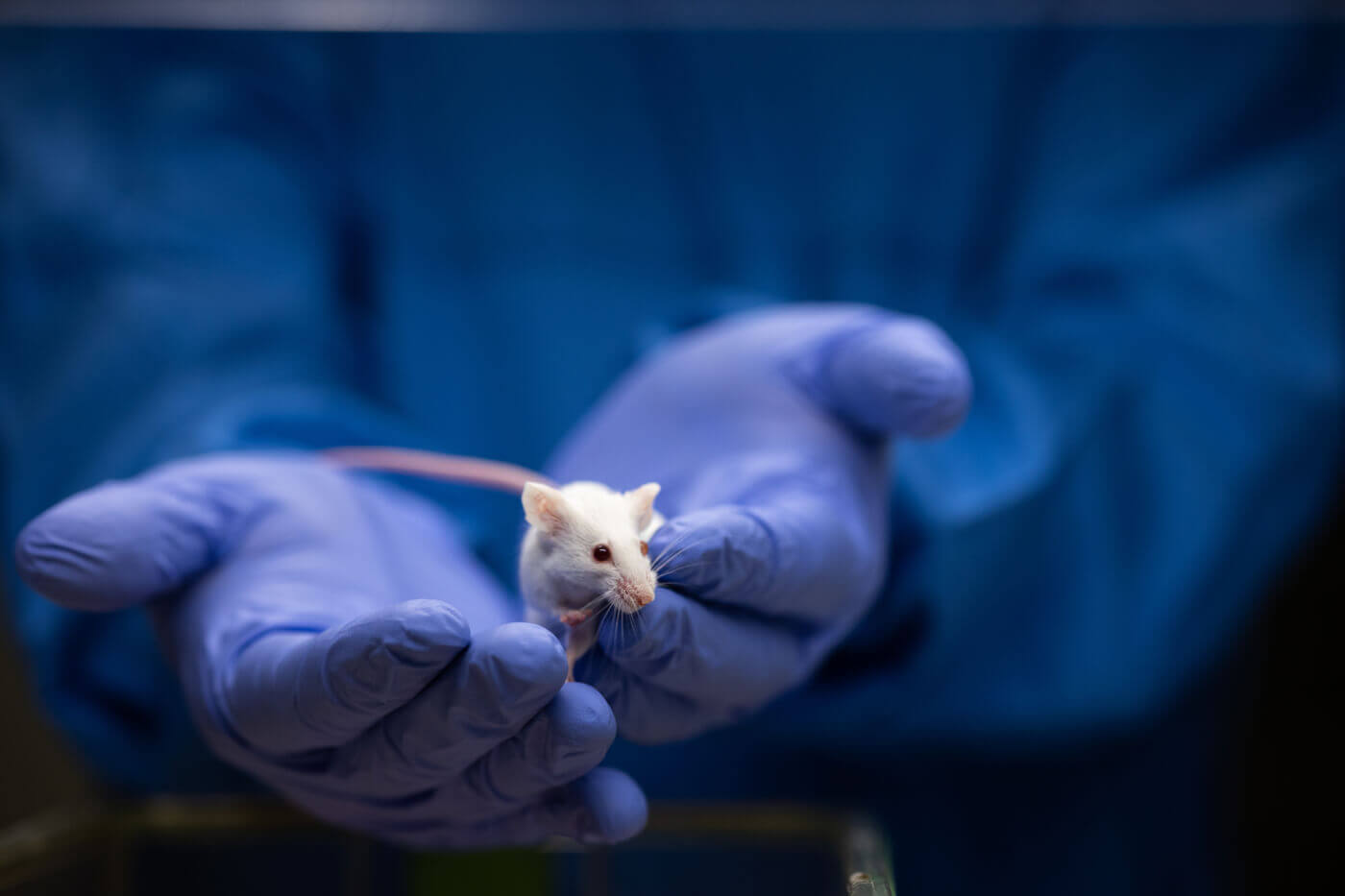Why Humanizing Mice Fails to Solve the Translatability Problem
Written by Gabby Vidaurre, Ph.D.
December 2024
From Genetics to Disease Modeling: A History of Mice in Research
The use of mice in experimentation spans over a century. These small animals were initially used in an attempt to study genetic defects and their physical consequences.1 From the early days of exploring genetic mutations to modern attempts to model human diseases like heart disease, cystic fibrosis, and Alzheimer’s disease, the use of mice has been ubiquitous in much of biomedical research.2–4 However, despite (and perhaps owing to) their extensive use, the scientific community must now confront a critical question: Has it become too reliant on a flawed model that increasingly fails to represent human biology?
The disturbing reality is that the vast majority of treatments that show promise in mice never make it to successful clinical application in humans. Around 95% of treatments that show promise in mice fail in human clinical trials.5–7 This failure is not a statistical anomaly; it highlights the profound differences between species. For example, the immune systems of mice and humans diverge in the types and levels of proteins and cells, respond to harmful foreign entities differently, and vary drastically in size. These differences mean that immunological disease research in mice is not applicable to humans,8–11 and other research fields are similarly affected. Mice and humans also differ in how genes are expressed and function, leading to both obvious phenotypic variations and more subtle yet critical disparities in physiology. Mouse hemoglobin, for example, has a lower affinity for oxygen than human hemoglobin, a potential reason for the mouse’s higher metabolic rate.12 While these significant biological differences between humans and mice have appropriately led some scientists away from using mice entirely, others are grasping at straws, tweaking their mouse models in an attempt to improve their relevance to human biomedical research.13
Humanized Mice: Not So Human After All
One of these desperate tweaks is “humanized” mice. Experimenters engraft human cells or tissues into a mouse in an attempt to study human diseases using the “laboratory tool” they’ve grown accustomed to: small animals.13 Components of the human immune system, skin tissue, pancreatic islets, neural cells, and more have been engrafted into mice,14–17 with human immune system components being the most extensively used.18–21 Although some scientists claim that humanized mice represent the future of human disease studies, others disagree, citing significant fundamental flaws, including invasive procedures for “successful” engraftment, incomplete functionality of engrafted tissues in an incompatible environment, and the lack of standardization across laboratories.
Experimenters often perform invasive procedures in their efforts to get the engrafted human cells to function. These include partially removing some of the mouse’s tissues or removing the mouse’s immune system components to create an open niche for the insertion of human cells or tissues.13 For example, to study hepatitis pathogenesis, mice are first genetically modified to be immunodeficient, and parts of their livers are removed before the engraftment of human hepatocyte cells.22 The need for drastic genetic manipulations and tissue alterations to ensure the human tissue functions in an individual of another species raises questions about the efficacy of human disease studies using humanized mice.
Although humanized mice are currently used in attempts to study diseases such as HIV, hepatitis B, and sepsis, the engrafted organ systems affected by these diseases are not fully functional in these mice. Even when repopulated with human immune components, humanized mouse models cannot replicate all aspects of the human immune system. Humanized mice often fail to produce essential blood cells, such as myeloid cells and natural killer cells, or antibody-producing cells needed to fight foreign invaders.23,24 To try to study the hematopoietic and lymphoid systems in humanized mice, both cell types are engrafted; however, mutations creating these immunodeficient mice result in decreased lymphoid tissue cells and limited lymph node development, hindering the study of these systems.25,26 Although scientists have created humanized mouse models to study disease pathology, results from these experiments are inaccurate and misleading since key cell types and functions of human organ systems are missing.
Another concern often overlooked is the interaction between the engrafted cells and the rest of the mouse’s body. Even though immunodeficient mice are engineered with the intent to study only the engrafted human immune system, the immune system encompasses many organ systems, including the skin, gastrointestinal and respiratory tract. For example, the microbial environment of the gut plays a significant role in immune response.27,28 Additionally, most diseases affect more than one organ system. Sepsis is a multi-organ condition, and the lack of crosstalk between the grafted human immune system and the mouse’s organs creates an insurmountable translational barrier.27,29 Without this crosstalk, experimenters cannot accurately predict how treatments and their resulting side effects might affect the human body as a whole.
Another issue confounding experiments on humanized mice is the lack of standardization between laboratories. This is sometimes due to the necessity of obtaining tissues and cells from multiple live human donors, as many more cells than would naturally be found within a single human may be needed for successful engraftment. For example, hematopoietic stem cells pooled from multiple donors are often used to ensure viable engraftment. This results in the formation of a heterogenous immune system that complicates findings related to immune response, as the immune system attacks both the disease of interest and itself. There is also no standardized method for reporting the information needed for these studies to be replicated.30 The lack of standardization in these models further undermines the reliability of humanized mouse models, as findings are often irreproducible across laboratories.
21st Century Disease Modeling: Embracing Human-Based Methodologies
Reflecting on the challenges inherent in using humanized mice, it’s clear that the research community must evolve. Effective human-relevant methodologies are already being used to study conditions for which humanized mice are extensively used, such as HIV, sepsis, and cancer. Researchers are using single-cell multi-omics to study differences in T cells and protein expression between healthy and HIV-infected patients with the goal of uncovering novel targets for immunotherapy.31–33 Scientists have developed human iPSC-derived liver organoids to model liver dysfunction during sepsis and the successful recovery of normal function after infection removal, demonstrating the functionality of this model to test and treat the effects of sepsis on the liver.34 Using patient-derived pancreatic cancer-on-a-chip, bioengineers recapitulated a functional tumor microenvironment that responds to anti-tumor treatment.35
The research community must embrace non-animal, human-based methods, train others in their use, and push for increased funding of these approaches, including computational modeling, in vitro systems (organ-on-a-chip, organoids, personalized medicine using patient-derived stem cells), and human omics research. This will increase the number, availability, advancement, and validation of these human-based models, paving the way for more reliable advancements in drug development for cancer and infectious diseases.
Funders and policymakers must play key roles, directing resources and priorities toward basic and preclinical models that use human cells and data to study these conditions. Continued investment in humanized mice pilfers funding, effort, and time from the use of more effective human models. These human-based models avoid the confounds inherent in trying to make one species more like another and allow researchers to replicate studies and solidify conclusions, facilitating increased translation from preclinical to clinical research.
More funding opportunities from the NIH and other government entities must be provided for non-animal research instead of those seeking new ways to “humanize” other species. Dedicated funding will incentivize researchers to embrace non-animal methods, as many have spent their entire careers using animal models and need a push to evolve. Training and career development opportunities emphasizing non-animal methods would also encourage researchers to adopt these approaches in their laboratories. With more reliable models, scientists can accurately assess newly developed drugs, saving time and money. Standardized, validated, human biology-based methods will decrease the time needed to discover and develop effective treatments and cures.
If scientists continue down the rabbit hole of creating and adjusting humanized mouse models, they risk spending excessive time and money on something that does little to address their actual research questions, for which they often receive public funding. The ultimate focus must be on finding the best ways to understand and improve human health and disease. By embracing human-relevant research, we uphold the most crucial tenets of scientific inquiry: rigor, reproducibility, and ethics.
1Clarke T. Mice make medical history. Nature. Published online December 5, 2002. Accessed December 18, 2024. doi:10.1038/news021202-10
2Plump AS, Smith JD, Hayek T, et al. Severe hypercholesterolemia and atherosclerosis in apolipoprotein E-deficient mice created by homologous recombination in ES cells. Cell. 1992;71(2):343-353. doi:10.1016/0092-8674(92)90362-G
3Tata F, Stanier P, Wicking C, et al. Cloning the mouse homolog of the human cystic fibrosis transmembrane conductance regulator gene. Genomics. 1991;10(2):301-307. doi:10.1016/0888-7543(91)90312-3
4Games D, Adams D, Alessandrini R, et al. Alzheimer-type neuropathology in transgenic mice overexpressing V717F β-amyloid precursor protein. Nature. 1995;373(6514):523-527. doi:10.1038/373523a0
5Panitch HS, Haley AS, Hirsch RL, Johnson KP. Exacerbations of multiple sclerosis in patients treated with gamma interferon. Lancet. 1987;329(8538):893-895. doi:10.1016/S0140-6736(87)92863-7
6Van Der Worp HB, Howells DW, Sena ES, et al. Can animal models of disease reliably inform human studies? PLoS Med. 2010;7(3):e1000245. doi:10.1371/journal.pmed.1000245
7Akhtar A. The flaws and human harms of animal experimentation. Camb Q Healthc Ethics. 2015;24(4):407-419. doi:10.1017/S0963180115000079
8Mestas J, Hughes CCW. Of mice and not men: Differences between mouse and human immunology. J Immunol. 2004;172(5):2731-2738. doi:10.4049/jimmunol.172.5.2731
9Doeing DC, Borowicz JL, Crockett ET. Gender dimorphism in differential peripheral blood leukocyte counts in mice using cardiac, tail, foot, and saphenous vein puncture methods. BMC Clin Pathol. 2003;3(1):3. doi:10.1186/1472-6890-3-3
10Gordon J. Modelling the human immune response: can mice be trusted? Curr Opin Pharmacol. 2001;1(4):431-435. doi:10.1016/S1471-4892(01)00074-1
11Farrar JD, Smith JD, Murphy TL, Leung S, Stark GR, Murphy KM. Selective loss of type I interferon-induced STAT4 activation caused by a minisatellite insertion in mouse Stat2. Nat Immunol. 2000;1(1):65-69. doi:10.1038/76932
12Perlman RL. Mouse models of human disease: An evolutionary perspective. Evol Med Public Health. Published online April 27, 2016. Accessed December 18, 2024. doi:10.1093/emph/eow014
13Fujiwara S. Humanized mice: A brief overview on their diverse applications in biomedical research. J Cell Physiol. 2018;233(4):2889-2901. doi:10.1002/jcp.26022
14McCune J, Namikawa R, Kaneshima H, Shultz L, Lieberman M, Weissman I. The SCID-hu mouse: murine model for the analysis of human hematolymphoid differentiation and function. Science. 1988;241(4873):1632-1639. doi:10.1126/science.241.4873.1632
15Melican K, Michea Veloso P, Martin T, Bruneval P, Duménil G. Adhesion of Neisseria meningitidis to dermal vessels leads to local vascular damage and purpura in a humanized mouse model. PLoS Pathog. 2013;9(1):e1003139. doi:10.1371/journal.ppat.1003139
16Brehm MA, Cuthbert A, Yang C, et al. Parameters for establishing humanized mouse models to study human immunity: Analysis of human hematopoietic stem cell engraftment in three immunodeficient strains of mice bearing the IL2rγnull mutation. Clin Immunol. 2010;135(1):84-98. doi:10.1016/j.clim.2009.12.008
17Chen C, Kim WY, Jiang P. Humanized neuronal chimeric mouse brain generated by neonatally engrafted human iPSC-derived primitive neural progenitor cells. JCI Insight. 2016;1(19). doi:10.1172/jci.insight.88632
18Mosier DE, Gulizia RJ, Baird SM, Wilson DB. Transfer of a functional human immune system to mice with severe combined immunodeficiency. Nature. 1988;335(6187):256-259. doi:10.1038/335256a0
19Ishikawa F, Yasukawa M, Lyons B, et al. Development of functional human blood and immune systems in NOD/SCID/IL2 receptor γ chainnull mice. Blood. 2005;106(5):1565-1573. doi:10.1182/blood-2005-02-0516
20Melkus MW, Estes JD, Padgett-Thomas A, et al. Humanized mice mount specific adaptive and innate immune responses to EBV and TSST-1. Nat Med. 2006;12(11):1316-1322. doi:10.1038/nm1431
21Yajima M, Imadome K, Nakagawa A, et al. A new humanized mouse model of Epstein‐Barr virus infection that reproduces persistent infection, lymphoproliferative disorder, and cell‐mediated and humoral immune responses. J Infect Dis. 2008;198(5):673-682. doi:10.1086/590502
22Dandri M, Burda MR, Török E, et al. Repopulation of mouse liver with human hepatocytes and in vivo infection with hepatitis B virus. Hepatology. 2001;33(4):981-988. doi:10.1053/jhep.2001.23314
23Marsden MD, Zack JA. Studies of retroviral infection in humanized mice. Virology. 2015;479-480:297-309. doi:10.1016/j.virol.2015.01.017
24Theocharides APA, Rongvaux A, Fritsch K, Flavell RA, Manz MG. Humanized hemato-lymphoid system mice. Haematologica. 2016;101(1):5-19. doi:10.3324/haematol.2014.115212
25Brehm MA, Shultz LD, Luban J, Greiner DL. Overcoming current limitations in humanized mouse research. J Infect Dis. 2013;208(suppl_2):S125-S130. doi:10.1093/infdis/jit319
26Chappaz S, Finke D. The IL-7 signaling pathway regulates lymph node development independent of peripheral lymphocytes. J Immunol. 2010;184(7):3562-3569. doi:10.4049/jimmunol.0901647
27Laudanski K, Stentz M, DiMeglio M, Furey W, Steinberg T, Patel A. Potential pitfalls of the humanized mice in modeling sepsis. Int J Inflamm. 2018;2018:1-9. doi:10.1155/2018/6563454
28Lambring CB, Siraj S, Patel K, Sankpal UT, Mathew S, Basha R. Impact of the microbiome on the immune system. Crit Rev Immunol. 2019;39(5):313-328. doi:10.1615/CritRevImmunol.2019033233
29Schouten M, Wiersinga WJ, Levi M, Van Der Poll T. Inflammation, endothelium, and coagulation in sepsis. J Leukoc Biol. 2008;83(3):536-545. doi:10.1189/jlb.0607373
30Stripecke R, Münz C, Schuringa JJ, et al. Innovations, challenges, and minimal information for standardization of humanized mice. EMBO Mol Med. 2020;12(7):e8662. doi:10.15252/emmm.201708662
31Collora JA, Liu R, Pinto-Santini D, et al. Single-cell multiomics reveals persistence of HIV-1 in expanded cytotoxic T cell clones. Immunity. 2022;55(6):1013-1031.e7. doi:10.1016/j.immuni.2022.03.004
32Wang XM, Zhang JY, Xing X, et al. Global transcriptomic characterization of T cells in individuals with chronic HIV-1 infection. Cell Discov. 2022;8(1):29. doi:10.1038/s41421-021-00367-x
33Ma T, McGregor M, Giron L, et al. Single-cell glycomics analysis by CyTOF-Lec reveals glycan features defining cells differentially susceptible to HIV. eLife. 2022;11:e78870. doi:10.7554/eLife.78870
34Li Y, Nie Y, Yang X, et al. Integration of Kupffer cells into human iPSC-derived liver organoids for modeling liver dysfunction in sepsis. Cell Rep. 2024;43(3):113918. doi:10.1016/j.celrep.2024.113918
35Haque MR, Wessel CR, Leary DD, Wang C, Bhushan A, Bishehsari F. Patient-derived pancreatic cancer-on-a-chip recapitulates the tumor microenvironment. Microsyst Nanoeng. 2022;8(1):36. doi:10.1038/s41378-022-00370-6


